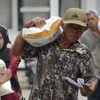Lao people started their traditional New Year festival - Bun Pi Mai - on April 14 with a host of festive activities.
The first day of the three-day Bun Pi Mai is called Sangkhane Luang, or the last day of the old year. On the day, people clean their houses in preparation for the New Year. They earn merit and blessings by building mounds of sand, usually on the river banks and temple grounds, which are then decorated with small triangular flags, flowers, money, and candles.
The second day, on April 15, is called Sangkhane Nao, the day between the old and the New Year; it is considered neither part of the old year nor the New Year. Sangkhane Nao is also known as the day of rest and all work is forbidden. Only festive activities are to take place, such as visiting relatives and friends, taking a day trip or the customary throwing of water on friends and passersby.
People also splash water onto one another as well as houses, livestock, and production tools to wish for longevity, happiness, and wealth.
The third day of the Lao New Year festival is called Sangkhane Kheun Pi Mai. It is the start of the New Year and the most joyous day of the festival. People traditionally go to the temple and make offerings to earn merit.
This year’s traditional New Year festival takes place amid the 60 th anniversary of the Lao People’s Revolutionary Party and preparations for the 40 th National Day.
Laos has also organised a variety of activities showcasing its traditions and cultural diversity so as to attract tourists to the country during the festival.-VNA
The first day of the three-day Bun Pi Mai is called Sangkhane Luang, or the last day of the old year. On the day, people clean their houses in preparation for the New Year. They earn merit and blessings by building mounds of sand, usually on the river banks and temple grounds, which are then decorated with small triangular flags, flowers, money, and candles.
The second day, on April 15, is called Sangkhane Nao, the day between the old and the New Year; it is considered neither part of the old year nor the New Year. Sangkhane Nao is also known as the day of rest and all work is forbidden. Only festive activities are to take place, such as visiting relatives and friends, taking a day trip or the customary throwing of water on friends and passersby.
People also splash water onto one another as well as houses, livestock, and production tools to wish for longevity, happiness, and wealth.
The third day of the Lao New Year festival is called Sangkhane Kheun Pi Mai. It is the start of the New Year and the most joyous day of the festival. People traditionally go to the temple and make offerings to earn merit.
This year’s traditional New Year festival takes place amid the 60 th anniversary of the Lao People’s Revolutionary Party and preparations for the 40 th National Day.
Laos has also organised a variety of activities showcasing its traditions and cultural diversity so as to attract tourists to the country during the festival.-VNA



















